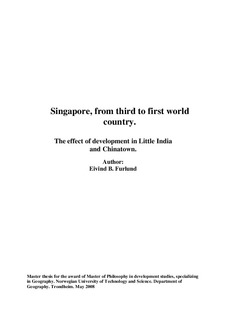| dc.contributor.author | Furlund, Eivind B | nb_NO |
| dc.date.accessioned | 2014-12-19T14:25:37Z | |
| dc.date.available | 2014-12-19T14:25:37Z | |
| dc.date.created | 2008-10-02 | nb_NO |
| dc.date.issued | 2008 | nb_NO |
| dc.identifier | 124648 | nb_NO |
| dc.identifier.uri | http://hdl.handle.net/11250/265248 | |
| dc.description.abstract | This dissertation explores the development of Singapore in the period from before Singapore’s independence (in 1965) until today. Singapore went from being a third world to becoming a first world country in a matter of decades. The change involved an impressive economic growth as well as an intensive modernization process. This paper answers questions concerning the effects of the modernization process in Chinatown and Little India in Singapore. How has the modernization process affected the built landscape, how has it changed the perception of the landscape, and what are the effects of conservation?
This paper argues that Singapore’s Peoples Action Party (PAP) government was influenced by the ideals of modernization theory when laying the foundations for the coming growth of Singapore, as western countries formed the ideal for Singapore’s future development. Theories of landscape, ethnicity and modernization make up the theoretical foundations of this paper.
By combining pre-recorded interviews with former residents, informal conversations with youths and personal in-depth interviews with stakeholders in the study areas, the narratives of the government and population are illustrated. Document review, picture analysis and observation are complimentary methods used to underline the findings further.
This dissertation concludes that the there is a gap between inhabitants and the government in terms of how the development process is viewed. Inhabitants and users of the Chinatown and Little India areas do not all share the government’s positive view. However, this gap has been narrowed by an intentional production of a national identity based on economic success and modernity as symbols of the Singaporean nation. Although the two areas have developed quite differently from each other over the years, Chinatown and Little India have both received conservation status. Conservation appears to have had a two-sided effect. In Chinatown tourism has become the primary industry, while Little India has made use of the incentives provided in terms of conservation to keep a focus on traditional trades. | nb_NO |
| dc.language | eng | nb_NO |
| dc.publisher | Fakultet for samfunnsvitenskap og teknologiledelse | nb_NO |
| dc.title | Singapore, from third to first world country: The effect of development in Little India and Chinatown | nb_NO |
| dc.type | Master thesis | nb_NO |
| dc.contributor.department | Norges teknisk-naturvitenskapelige universitet, Fakultet for samfunnsvitenskap og teknologiledelse, Geografisk institutt | nb_NO |
